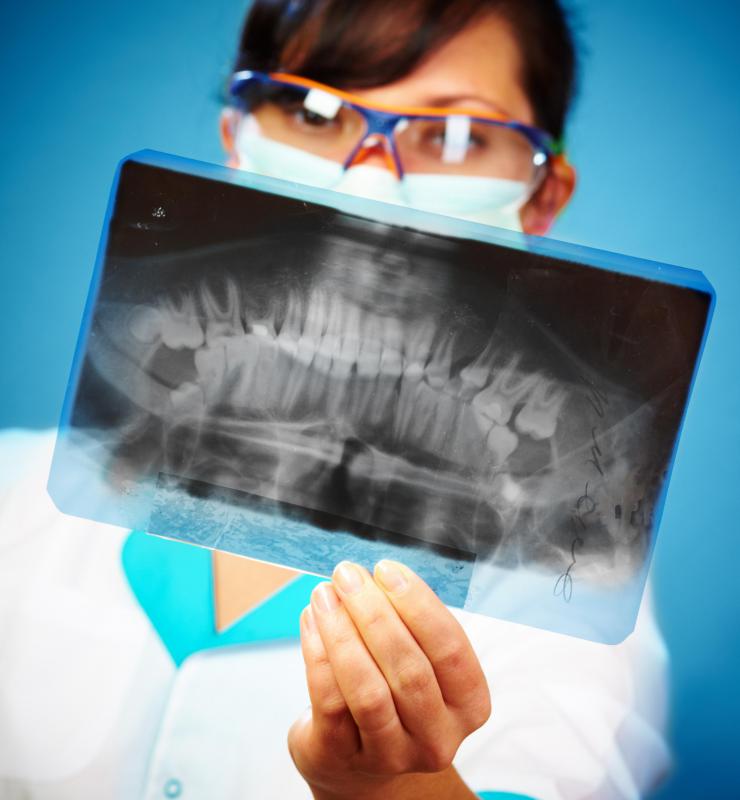At WiseGEEK, we're committed to delivering accurate, trustworthy information. Our expert-authored content is rigorously fact-checked and sourced from credible authorities. Discover how we uphold the highest standards in providing you with reliable knowledge.
What is a Class II Malocclusion?
A Class II malocclusion is a condition in which the upper teeth protrude past the lower teeth. This is commonly referred to as an overbite. The causes are varied, so the treatment will depend upon the cause as well as the severity of the malocclusion. Dentists usually prefer to begin treatment at the earliest age possible.
Early thumb sucking is believed by many dental professionals to be one reason a person is at risk for developing a Class II malocclusion. For this reason, many healthcare providers have begun to discourage the practice in children. The same is true of pacifier use, and most doctors and dentists prefer that children not use a pacifier later than age 3.
Sometimes, the teeth themselves can be the cause of the malocclusion. Abnormally shaped teeth, extra teeth, impacted teeth, or even missing teeth could lead to the problem.
A Class II malocclusion could be an issue for some people because of dental work. If crowns or braces do not fit properly, for example, they could push the teeth out of alignment. This makes regular dental visits extremely important.

A common cause is a misalignment of the jaw, which can be caused by genetic, or hereditary, factors. It also can occur as a result of improper healing after a fracture. Rarely, the misalignment is because of the development of a tumor in the mouth or jaw.
A Class II malocclusion can present in several ways. Aside from an abnormal tooth alignment, sometimes the face itself will have a somewhat distorted appearance. The process of eating sometimes can be difficult or even painful because of chewing or biting problems. Speech and breathing also can be affected in rare instances.
A routine trip to the dentist is all that it takes in order to obtain a diagnosis. In the majority of cases, the dentist will be able to treat the condition in his or her office. In more severe cases, a referral to an orthodontist might be suggested.

Treatment is extremely individualized. For some, having one or more teeth removed will correct the problem, while others will benefit from the use of a retainer to correct the bite. Braces are often used for a more significant malocclusion. In the most severe cases, surgery might have to be performed.
AS FEATURED ON:
AS FEATURED ON:


















Discussion Comments
I'm a 21 year old girl. I have a serious dental problem. My upper teeth protrude outwards. There is a gap between the upper incisor and lower incisor when I close my mouth. I have worn braces but it didn't make any difference.
My teeth are straight, so does this mean there is a jaw problem? When I speak, the defect becomes prominent because my lower teeth seems to be behind what is normal. Is there any treatment for this? Any surgery?
@googie98- I know that a “Class II malocclusion” sounds like something that a little thumb sucking could not cause. I am a dental assistant for a pediatric dentist and I cannot stress how important it is to stop your child from sucking their thumb.
We have a pamphlet that we give parents of children who still suck their thumb. It is full of suggestions that will help parents to help their children.
One thing that we suggest is to try to distract your child every time that you see him or her suck their thumb. Start an activity that would require them to use both of their hands.
Unfortunately, we had a mother who was so fed up with her 3-year-old sucking her thumb that she would put hot sauce in her mouth every time she saw her do it. We had to report it and DHR temporarily took her child until she went through parenting classes.
@googie98- Thumb sucking can definitely be a problem for a young child. One of my friend’s children sucked her thumb for many years. She was still sucking her thumb after her permanent teeth came in, causing a lot of damage to the alignment of her teeth and the roof of her mouth.
I work for a pediatrician and she has suggested that nagging your child about it will just make them want to do it more. She said that, just as you did when they started using the potty, encourage them, and let them know how proud you are of them when they are not sucking their thumb. Use positive reinforcement and let them know that they are a big boy/girl and that they don’t have to wear diapers, drink out of bottles or suck their thumbs.
One of my friends has a 6-year-old son who still sucks his thumb. When you tell him to stop, as soon as you turn your back, he is doing it again. She is very concerned about the possible damage to his teeth.
What can you do to prevent or even stop a child from sucking his or her thumb?
Post your comments